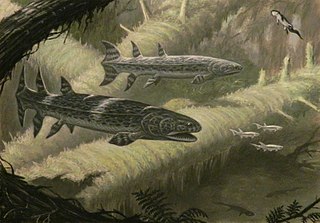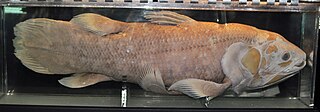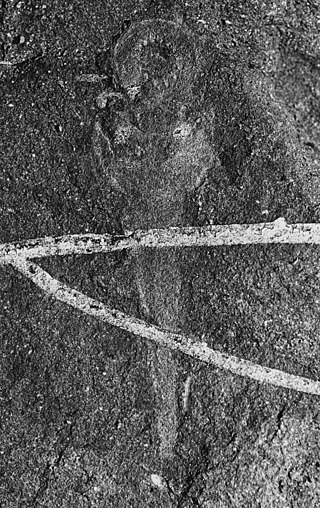
Hyneria is a genus of large prehistoric predatory lobe-finned fish which lived in fresh water during the Famennian stage of the Devonian period.

Bothriolepis was a widespread, abundant and diverse genus of antiarch placoderms that lived during the Middle to Late Devonian period of the Paleozoic Era. Historically, Bothriolepis resided in an array of paleo-environments spread across every paleocontinent, including near shore marine and freshwater settings. Most species of Bothriolepis were characterized as relatively small, benthic, freshwater detritivores, averaging around 30 centimetres (12 in) in length. However, the largest species, B. rex, had an estimated bodylength of 170 centimetres (67 in). Although expansive with over 60 species found worldwide, comparatively Bothriolepis is not unusually more diverse than most modern bottom dwelling species around today.

Groenlandaspis is an extinct genus of arthrodire from the Late Devonian. Fossils of the different species are found in late Devonian strata in all continents except eastern Asia. The generic name commemorates the fact that the first specimens of the type species were found in Greenland.

The West Indian Ocean coelacanth is a crossopterygian, one of two extant species of coelacanth, a rare order of vertebrates more closely related to lungfish and tetrapods than to the common ray-finned fishes. The other extant species is the Indonesian coelacanth.

Diplocercides is an extinct genus of marine coelacanth which lived during the Late Devonian period.
Chagrinia is an extinct genus of prehistoric marine coelacanth which lived during the Late Devonian period.

The South African National Roads Agency SOC Ltd or SANRAL is a South African parastatal responsible for the management, maintenance and development of South Africa's proclaimed National Road network which includes many National ("N") and some Provincial and Regional ("R") route segments.

Gondwanascorpio emzantsiensis is an extinct Gondwanan scorpion that lived 360 million years ago in the Devonian. Its fossil remains, clearly showing pincer and sting, were discovered in rocks of the Witteberg Group near Grahamstown in South Africa. At present, this scorpion is the oldest known land-dwelling animal from Gondwana, which in Devonian times was separated from Laurasia by a deep ocean. At the time, the fossil site was only 15° from the South Pole, but rather than arctic-like tundra, the region was probably wooded, providing ample insect life for food. Previously, only two scorpion species were known from the late Devonian – Hubeiscorpio gracilitarsus from China and Petaloscorpio bureaui from Canada. The species was described by Robert Gess of Wits University in the journal African Invertebrates. The specific epithet derives from umZantsi, the isiXhosa word for "south", sometimes used for South Africa.

Priscomyzon riniensis is an extinct lamprey that lived some 360 million years ago during the Famennian in a marine or estuarine environment in South Africa. This small agnathan is anatomically similar to the Mazon Creek lampreys, but is some 35 million years older. Its key developments included the first known large oral disc, circumoral teeth and a branchial basket.

Antarctilamna is an extinct genus of Devonian cartilaginous fish originally exemplified by Antarctilamna prisca from South Eastern Australia and Antarctica. The latest occurring described species is Antarctilamna ultima from the Waterloo Farm lagerstätte in South Africa. Antarctilamna has robust ctenacanthid-like spines which lack a deep insertion area, and are borne in front of the first dorsal fin; in addition to distinctive diplodont teeth with small intermediate cusps. Antarctilamna-like spines, known from the Bunga Beds locality in Australia have been ascribed to A. prisca.

Plesioselachus is an extinct genus of Late Devonian (Famennian) cartilaginous fish with uncertain classification, which contains only one species, P. macracanthus from the Waterloo Farm lagerstätte in South Africa. Known from a single incomplete articulated skeleton and some isolated remains, it is characterized by having a long dorsal spine with length about one third of body length.

Umzantsia is an extinct genus of limbed stegocephalians from the Devonian of South Africa. It contains a single species, Umzantsia amazana. The genus is based on ~360 million year old skull and shoulder bones from the Waterloo Farm lagerstätte, a locality on the south-eastern coast of South Africa. In the Devonian, this area of Gondwana was located within the Antarctic Circle. Together with the find of Tutusius umlambo from the same locality, this provides the first evidence that Devonian limbed vertebrates were not restricted to the tropics as was formerly believed, and suggests that they may have been global in distribution. Waterloo Farm fossils have been metamorphosed and intensely flattened, with the bone tissue replaced by secondary metamorphic mica that is partially altered to kaolinite and chlorite during uplift. They also provide the first evidence of Devonian limbed vertebrates from the continent of Africa, and only the second and third such taxa from Gondwana.

The Waterloo Farm lagerstätte is a Famennian lagerstätte in South Africa that constitutes the only known record of a near-polar Devonian coastal ecosystem.

Diplacanthus is an extinct genus of Mid to Late Devonian fish in the class Acanthodii, known as spiny sharks.
Hexachara is a genus of fossil charophyte that is likely to have formed meadows within sheltered oligohaline reaches of lakes.

Naiadites is an extinct genus of thin-shelled non-marine bivalve from the Upper Carboniferous coal-measures of Nova Scotia in Canada.

Octochara is a genus of fossil charophyte from the Famennian. It is one of two genera of charophyte described from the Waterloo Farm lagerstätte in southern Africa. It and Hexachara, from the same locality provide the oldest record of reconstruct able charophytes with in situ oogonia.

Isityumzi mlomomde is fossil lungfish described from fragmentary remains including one complete parasphenoid, tooth plates fragments and scales from the Late Devonian Sarcopterygians. It represents the only record of Late Devonian lungfish remains from western Gondwana.

Hungerfordia is a genus of presumed marine algae first described by Fry and Banks in 1955 in describing Hungerfordia dichotoma from Late Devonian strata. It has been interpreted as a probable brown (Phaeophyte) algae though the possibility that it represents a red (Rhodophyte) alga is not excluded - the taxonomic challenge being that modern red and brown algae are differentiated on the basis of colour and cellular structure which are not preserved in the fossil taxa. Douglas and Jell (1985) suggested that Buthotrephis trichotoma and B. divaricata should furthermore be transferred from Buthotrephis to Hungerfordia.
Kowieria is an extinct genus of lycopsid from the Late Devonian from Waterloo Farm, containing the single species Kowieria alveoformis. As of 2021 it is being characterised as incertae sedis. It was first described in 2017 from a black shale layer interbedded with quartzite strata of the Famennian aged Witpoort Formation.
























